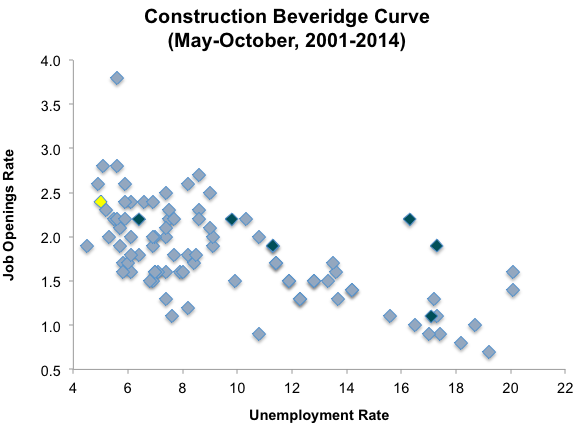Construction employers are reporting greater difficulty filling jobs, particularly for skilled positions. If current trends continue, there is a high likelihood that labor could be a major problem in construction later this year. In fact, this summer could be the most difficult year for filling construction jobs since the height of the housing bubble.
As I’ve written before, comparing the annual unemployment in construction to all industries is a poor measure of the availability of workers in the industry. Because construction work is by its nature temporary and seasonal, the construction industry will always have more turnover and higher average unemployment than other industries no matter what policies Washington, D.C. adopts.
The availability of workers is best seen in the ratio of the unemployment rate to the job openings rate in the current year compared to prior years in the industry. Graphing this information creates what economists refer to as a Beveridge curve. The ratio reflects the two best measures of the labor market health, and curve shows what a tight or loose labor market looks like in the industry: the tighter the labor market, the higher and further to the left the point will appear on the curve.
Below is the Beveridge curve for the construction industry based on data from the Bureau of Labor Statistics on the industry from 2001 to 2014. Each green highlighted point represents the summer month (May to October) with the tightest labor market in each year from 2009 to 2014 (starting with 2009 in the lower right and moving up and to the left to 2014). The yellow is the predicted point for this summer based on the average drop in the ratio over the last 5 years.
Each year since 2009, the ratio of unemployment to job openings in the month with the tightest labor market has declined by an average of 28 percent. In 2014, the ratio dropped by 35 percent. If current trends continue, the labor market for construction will be the tightest it has been since June of 2006 at the height of the housing bubble.
These numbers, of course, only reflect the national trends in the entire industry rather than specific occupations or areas within it. Some positions or locations could face even tighter labor markets. But based on these numbers alone, Congress should reconsider its prohibition on year-round construction workers and create a new guest worker program for construction and other lesser-skilled industries.
